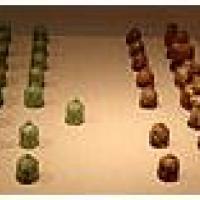
History of chess in Iran (Persia)
The Karnamak-i Ardeshir-i Papakan, a Pahlavi epical treatise about the founder of the Sassanid Persian Empire, mentions the game of chatrang as one of the accomplishments of the legendary hero, Ardashir I, founder of the Empire. The oldest recorded game in chess history is a 10th century game played between a historian from Baghdad and a pupil.
In the 11th century Shahnameh, Ferdowsi describes a Raja visiting from India who re-enacts the past battles on the chessboard. A translation in English, based on the manuscripts in the British Museum, is given below: One day an ambassador from the king of Hind arrived at the Persian court of Chosroes, and after an oriental exchange of courtesies, the ambassador produced rich presents from his sovereign and amongst them was an elaborate board with curiously carved pieces of ebony and ivory. He then issued a challenge:
"Oh great king, fetch your wise men and let them solve the mysteries of this game. If they succeed my master the king of Hind will pay tribute as an overlord, but if they fail it will be proof that the Persians are of lower intellect and we shall demand tribute from Iran."
The courtiers were shown the board, and after a day and a night in deep thought one of them, Bozorgmehr, solved the mystery and was richly rewarded by his delighted sovereign.
The appearance of the chess pieces had altered greatly since the times of chaturanga, with ornate pieces and chess pieces depicting animals giving way to abstract shapes. The Islamic sets of later centuries followed a pattern which assigned names and abstract shapes to the chess pieces, as Islam forbids depiction of animals and human beings in art. These pieces were usually made of simple clay and carved stone.